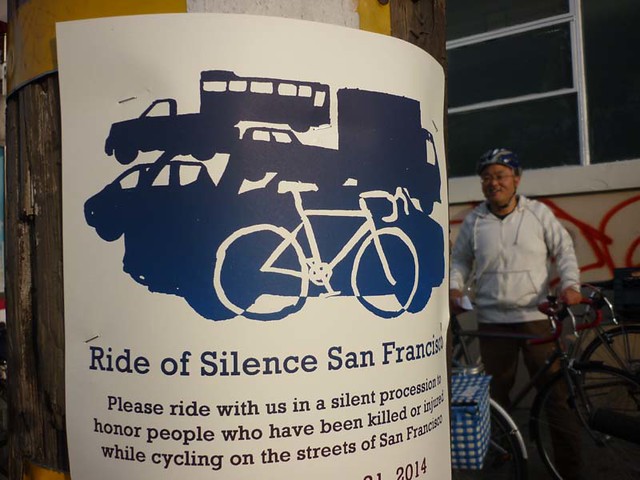
Last Wednesday night I joined about 80 fellow cyclists in a memorial ride to honor seven cyclists recently killed in the streets of San Francisco. The Ride of Silence, first held in Dallas in 2003 after endurance cyclist Larry Schwartz was hit by the mirror of a passing bus and was killed, is an annual silent procession to honor cyclists who have been killed or injured while cycling on public roadways that has spread to cities and towns across North America and the world.
Co-organized by my friend Anthony Ryan, himself a victim of having made the painful acquaintance with 3000 pounds of automobile mass a couple of years ago, the Ride of Silence SF had its 5th anniversary. The fact that it was the largest and most organized ride so far made it a particularly moving experience, but unfortunately also indicates that the tragedies in our streets are still common occurrences, despite efforts to make our streets safer for everyone. Last year alone, 25 pedestrians and bicyclists were hit and killed by drivers in San Francisco, the highest number since 2007.
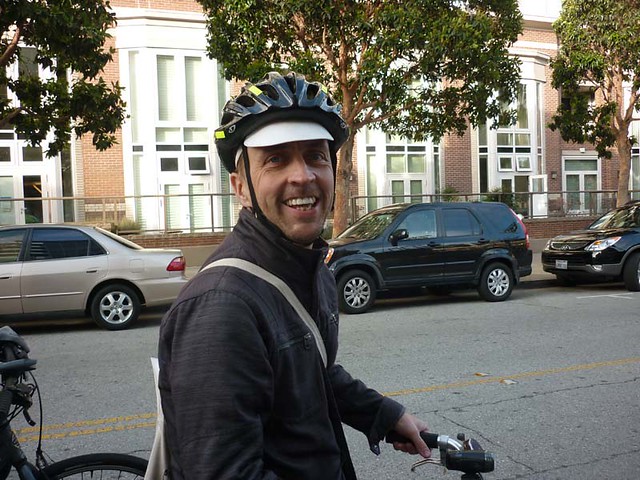
Anthony showing off his brandnew set of front teeth, while his original chompers are mixing it up with the San Francisco pavement.
This year’s route took us through parts of the Mission, SoMa and up Market Street, a particularly hairy patch of urban jungle, to memorialize six cyclists and a wheelchair-bound pedestrian that recently lost their lives during unsolicited encounters with cars and trucks. For the first time ever, the ride was accompanied by an entourage of motorcycle cops, who were going to make the streets just a bit safer for us than we’re used to on a daily basis.
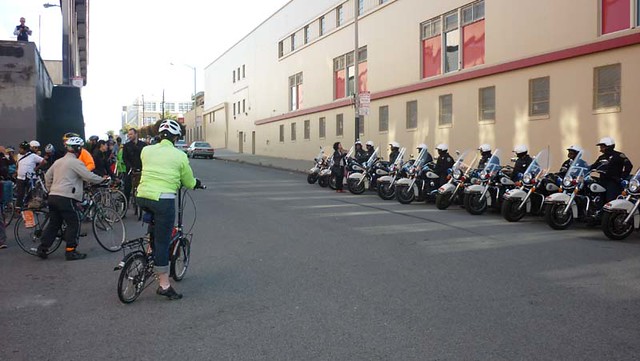
Seeing them sitting there waiting for us as we were gathering on the street behind Sports Basement added not only a sense of safety but symbolism, as it might signal a shift away from the common practice by the SFPD (and police across the Bay Area and the country) of treating non-motorized traffic participants as expendable inferiors. The “blame the victim” default that unfortunately still applies to most collisions involving cyclists and pedestrians not only makes it very difficult to get a real investigation into what actually happened, but it perpetuates the deep-seated privilege afforded to motorized vehicle operators on streets that in actuality belong to all of us.
A little after 6pm our procession on two wheels set off towards the San Francisco evening commute.
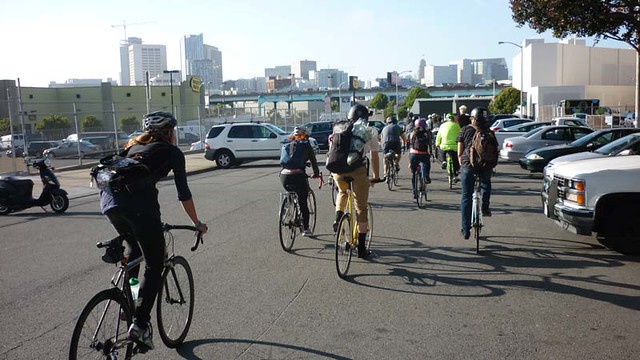
Cheng Jin Lai, 78, Bryant and 11th
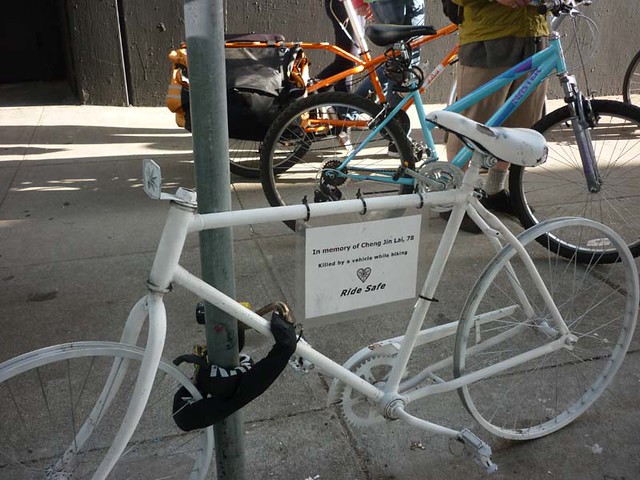
For Cheng Jin Lai, Bicycling Was a Necessary Means to an Active Life
Our first stop took us to one of the most crash-prone intersections in town at Bryant, Division, and 11th Streets, underneath the Central Freeway. Notorious for its poor design that encourages high speeds and provides little protection for cyclists, Mr. Lai got caught and crushed by the back-right tire of a Muni Bus as it was making a right turn. As it turned out, a standard-issue tire-guard designed specifically for Muni vehicles to prevent exactly this type of tragedy from happening was missing from this bus.
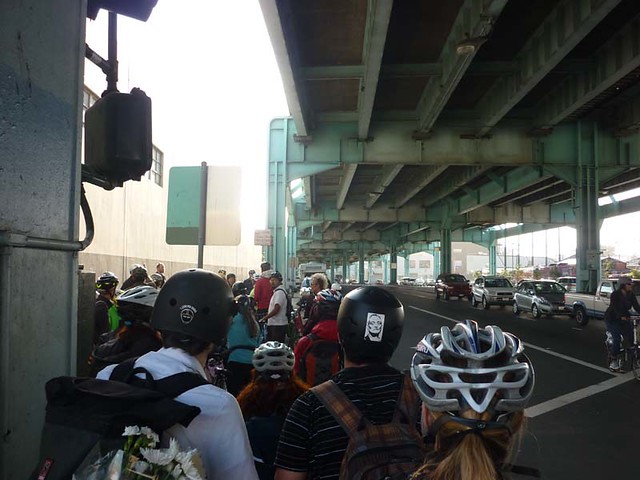
A moment of silence for Cheng Jin Lai under the Central Freeway
Our next stop was only two blocks up, and the reason we opted to push our bikes on the sidewalk…

is easily explained by taking a glance at what you would have to navigate if you were to ride on the street.
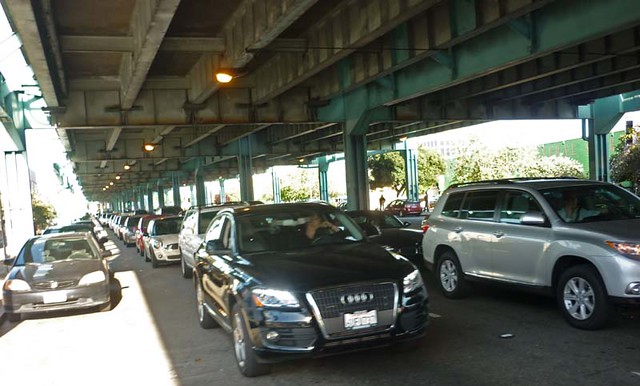
At the intersection of Folsom Street, we paid tribute to Harold Swaggard, a man who often felt ignored in life and was almost left ignored in death.
While Harold’s death lays bare a whole range of societal inequities beyond the circumstances of the collision that ended his life, it’s important to note that the price you pay for a moment of distraction in a car-privileged street is eminently more consequential for a cyclist than for a driver, regardless of who is being distracted.
By now I had worked my way to the front of the group to watch Anthony and one of his co-organizers, Devon Warner, set up Harold’s altar, consisting of his photo, a poster, and a bouquet of flowers, mounted on a street pole.
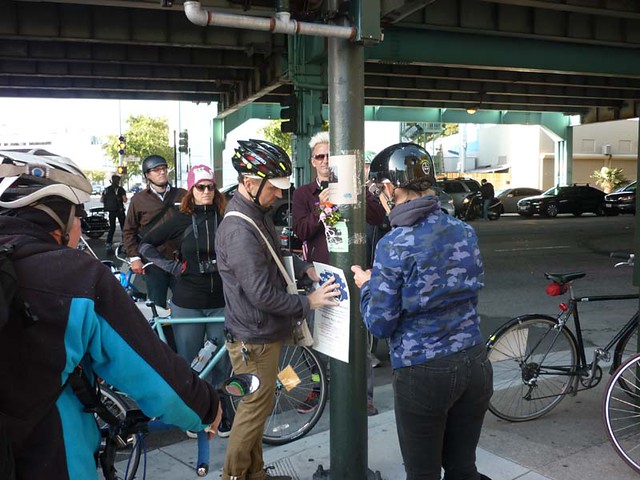
This was followed by a moment of silence accompanied by the deafening roar of cars and trucks speeding by. It was a visceral reminder not only of what it must have felt like during Harold’s last minutes on Earth, but also of the permanently aggravating soundtrack people who live in the streets are forced to endure day in and day out.
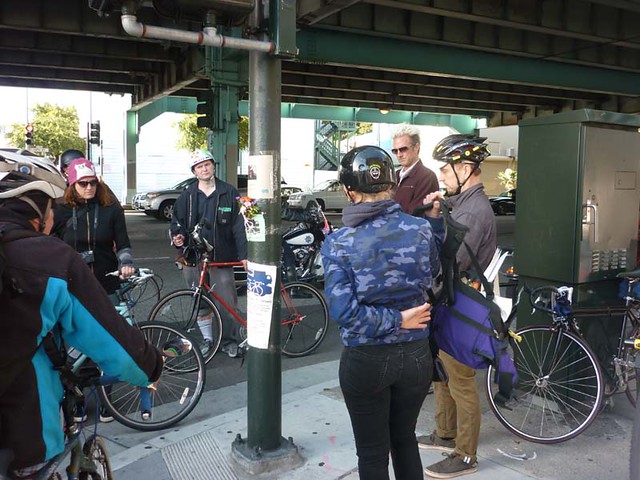
Next, we turned onto Folsom Street, where we had finally reached the nirvana of a bike lane. Thanks to our motorcycle cop entourage who were clearing intersections for us…

we were now experiencing what life might be like riding on a bike privileged street for once.
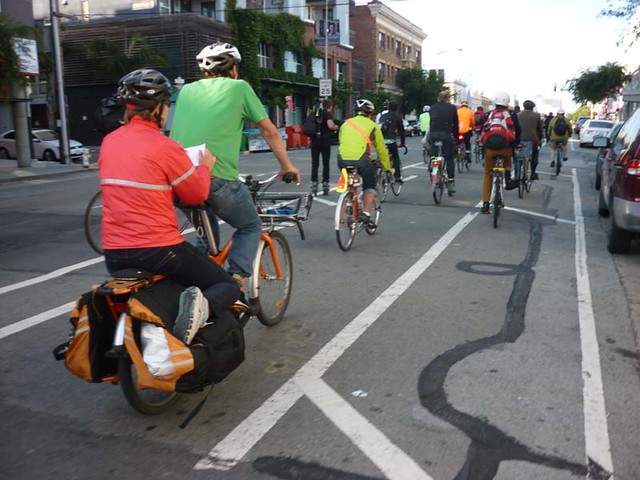
After a smooth 5 minute cruise down Folsom we arrived at the corner of 6th Street, scene of one of the most controversial and widely publicized incidents on San Francisco’s streets in recent years.
Amelie Le Moullac, 24, Folsom and Sixth
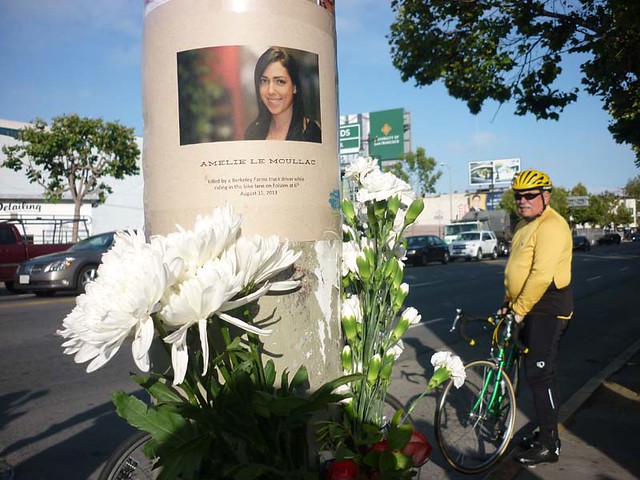
Remembering Amelie
Concerns Raised About Police Conduct in Bicyclist Fatality
Amelie was pedaling eastbound on Folsom Street just before Sixth Street on the morning of August 14, 2013 when she was struck and killed by a big rig making a right turn. The police determined that day that it must have been her fault, without any evidence (though claiming they searched for video footage from nearby business cameras). During a memorial at the site a week later, a San Francisco Bike Coalition staffer discovered surveillance video of the crash at a nearby auto shop while an SFPD Sergeant was blocking the bike lane to lecture mourners about bike safety.
The video (that would have been auto-deleted the following morning had it not been for the SF Bike staffer’s detective work) led the SFPD to conclude that the truck driver was at fault after all for making an unsafe turn into the bike lane. However, just last week San Francisco District Attorney George Gascón dropped the case because he felt the video evidence wasn’t enough to convince a jury.
Needless to say, Amelie’s family as well as the entire San Francisco cycling community has a hard time understanding how the truck driver could come out of this without as much as a ticket for a minor vehicle code violation. The message this sends is that it’s basically okay to kill cyclists and pedestrians as long as you are in a car or truck. And for cyclists and pedestrians it just spells out in a moment of rare honesty what everyone implicitly knows and understands — that these roads belong to cars, and you enter them at your own risk.
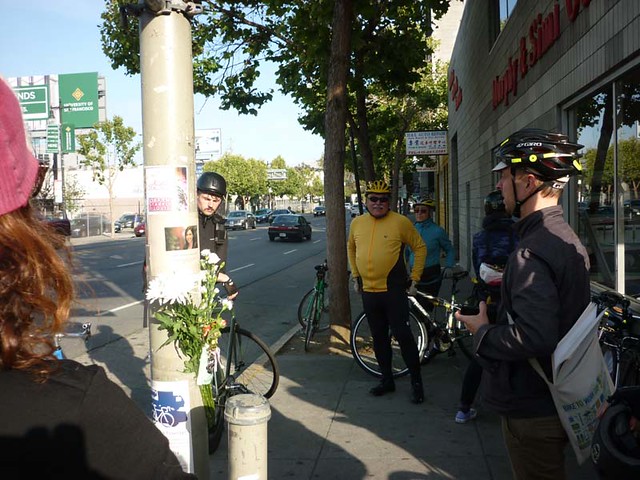
A moment of silence for Amelie Le Moullac
While we all tacitly accept car privilege as a fact of life, it’s important to note that it wasn’t always so. For example, the very notion of jaywalking as a tactic of shaming pedestrians for being in the street and blaming non-motorized people for their own demise had to first be invented by the car lobby to normalize the automobile as the default occupant of our public streets. This psychological and cultural shift that began in the 1920s is reflected today not only in our legal system and collective subconsciousness, but in all aspects of transportation policy.
 Consider: Only 2.1 percent of federal transportation dollars go to biking & pedestrian projects. Even in San Francisco, where you’re more likely to find a bike lane on any given street than in most other U.S. cities (thanks in large part to tireless advocacy by the SF Bicycle Coalition) the city’s transportation agency spends less than 1% of its budget on biking, less than on office supplies. This type of discriminatory spending not only keeps streets unsafe for cyclists and pedestrians, but the lack of investment in better bike and pedestrian infrastructure also discourages more people from getting out of their cars, keeping intact a vicious cycle. As the chart on the right shows, you get what you pay for, and the reason European cities like Amsterdam or Copenhagen are so bicycle and pedestrian-friendly is because their transportation budgets reflect those values.
Consider: Only 2.1 percent of federal transportation dollars go to biking & pedestrian projects. Even in San Francisco, where you’re more likely to find a bike lane on any given street than in most other U.S. cities (thanks in large part to tireless advocacy by the SF Bicycle Coalition) the city’s transportation agency spends less than 1% of its budget on biking, less than on office supplies. This type of discriminatory spending not only keeps streets unsafe for cyclists and pedestrians, but the lack of investment in better bike and pedestrian infrastructure also discourages more people from getting out of their cars, keeping intact a vicious cycle. As the chart on the right shows, you get what you pay for, and the reason European cities like Amsterdam or Copenhagen are so bicycle and pedestrian-friendly is because their transportation budgets reflect those values.
Another lesser known but perhaps even more insidious force in keeping us wed to the automobile is a city planning tool called “Level of Service,” an arcane metric of measuring traffic that puts the movement of motor vehicles above all other considerations. For example, if a bus or bicycle lane proposal is projected to reduce the number of cars that can make it through a given intersection, it negatively affects the Level of Service and thus has a slim chance of being adopted. While cities are trying to figure out new and creative ways around this hurdle to most traffic-calming measures, it is still our default for measuring mobility in the same limited way that GDP is our default for measuring wealth.
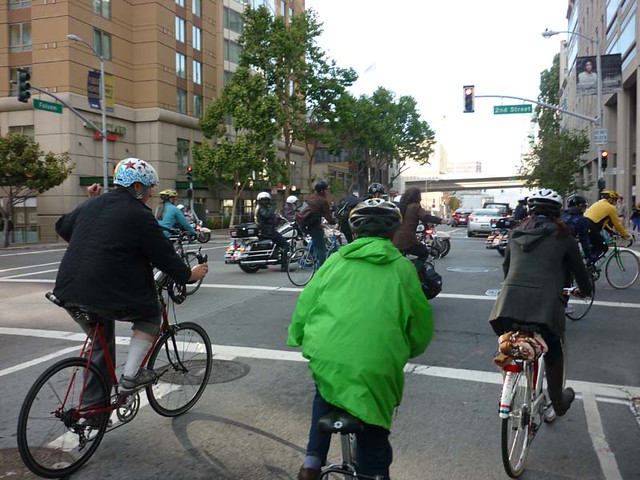
Real Level of Service: The number of cyclists that can pass through an intersection at any one time.
The good news in all this is that we know car-dominated streets aren’t an inherent human condition, but simply the result of choices we’ve made. As many cities in Europe have shown, it is not that difficult to create safer infrastructure for everyone, including drivers, when we collectively decide that’s what we want. The fact that a long stalled plan to create an extra wide bright green bike lane on Folsom Street between 11th and 4th streets that merges motorists and cyclists more safely all of a sudden got funded and was quickly installed after Amelie’s tragic death shows that it’s often just a matter of priority and political will. It’s just sad that people have to lose their lives before we do what’s right, makes sense, and frankly, is not that expensive.
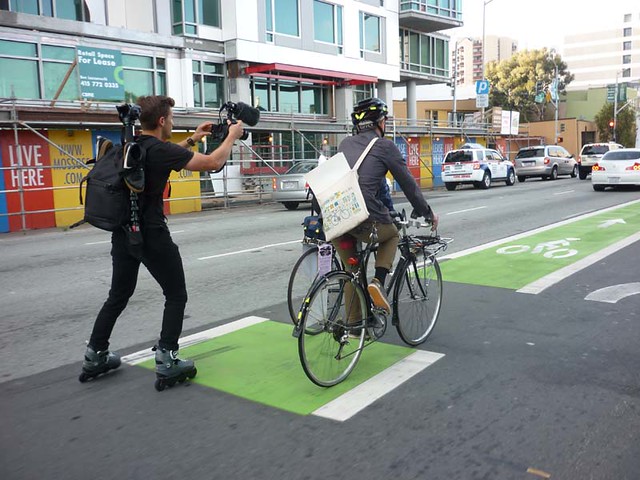
Taking a lane from drivers to create safer cycling along fast-moving Folsom Street. The green lane narrows and breaks up as it approaches the right turns on 10th, 8th, and 6th streets to communicate how to safely merge and avoid having cars make the unsafe “right hook” turns that are dangerous to cyclists. KQED cameraman Jeremy Raff is filming Devon and Anthony as they’re riding on the safe green.
We continued towards downtown, and took a right on Second Street, where rush hour traffic was dense and unrelenting. As we got closer to our next destination on King Street near the Giants ballpark, not even the cops were able to keep us together anymore. It was back to how it is when you’re by yourself on a bike in a sea of traffic, just trying to get through it alive.
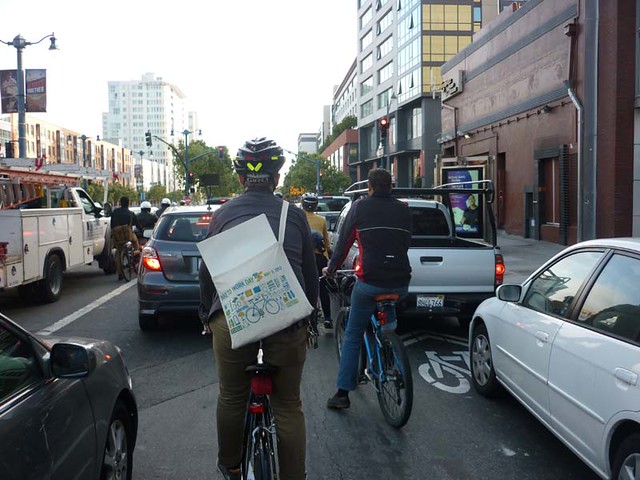
Our group reunited at King and Third Street, the site of another heartbreaking and unnecessary loss of life.
 Diana was run over by a cement truck driver, right in front of the ballpark where crowds of pedestrians were headed to a Giants event at the time. While Third Street has had a bike lane since 2003, at the time of Diana’s death it suffered from a very common condition that anyone who has ever ridden a bike is familiar with: Sudden Disappearance Syndrome. These kinds of holes in the bicycle infrastructure can be even more dangerous than not having a bike lane at all, as it creates a false sense of separation for both motorists and cyclists before being abruptly tossed back into each other’s path.
Diana was run over by a cement truck driver, right in front of the ballpark where crowds of pedestrians were headed to a Giants event at the time. While Third Street has had a bike lane since 2003, at the time of Diana’s death it suffered from a very common condition that anyone who has ever ridden a bike is familiar with: Sudden Disappearance Syndrome. These kinds of holes in the bicycle infrastructure can be even more dangerous than not having a bike lane at all, as it creates a false sense of separation for both motorists and cyclists before being abruptly tossed back into each other’s path.
While the problem has since been (partially) addressed by moving the bike sharrow — a painted bicycle indicating to drivers that cyclists do indeed share the road and have the right to the full lane — from the curb to the middle of the lane, it’s still far from a safe and equitable solution. It’s that same chicken/egg dilemma again, where the car-privilege is so culturally indoctrinated in our brains that most drivers don’t perceive cyclists as equal traffic participants even if it’s painted on the street right in front of them, and cyclists often don’t make use of their legal right to take the full lane because it doesn’t help you to have been right when you’re dead.
So really, the only way to change that dynamic is to invest in dedicated — or better yet — separated bike lanes, like the new bright green, protected, designed and landscaped “contra-flow” lane on two blocks of Polk Street. Not only that, but in order to ensure a safe commute for cyclists that in turn will encourage more people to get out of their cars and on their bikes you have to have a comprehensive vision for your entire city, something the SF Bike Coalition has done with their Connecting the City proposal. The city sort of supports it, but generally still has a hard time putting their money where their mouth is.
We pedaled down Third Street and turned left on Market Street, San Francisco’s signature boulevard that is a bustling economic and social hub. It also is one of the city’s main transit spines, connecting downtown with the rest of the city. On the lower part of Market there’s still no real bike lane, so when you don’t have a police escort, this narrow stretch can feel like the wild west, with cars, buses, trams and bicycles all trying to work their way through this dense, high volume artery.
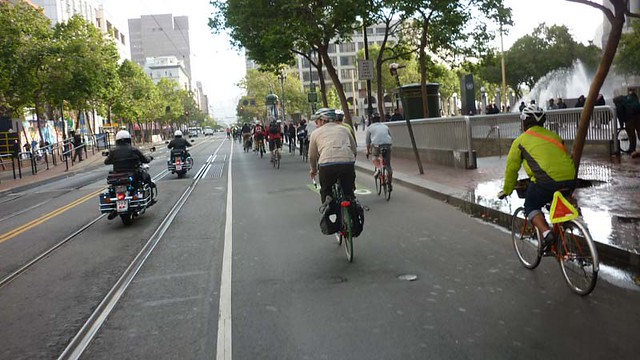
As you get up to mid-Market, you first get treated to a painted bike lane, which a few blocks later turns into a fully separated green bike lane.
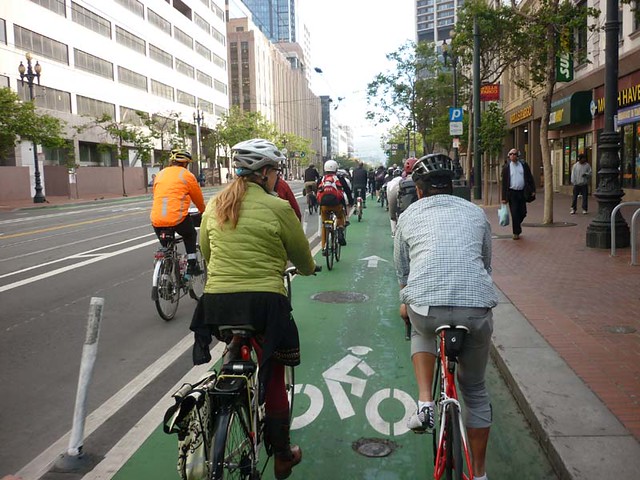
These new lanes have vastly improved the riding experience on Market compared to the dangerous chaos of yore, with thousands of cyclists, many of them commuters, taking this route every day. In fact, Market Street now carries more people on bike than it does people driving, which not only shows the boulevard’s importance in the city’s bike plan, but how just a little bit of infrastructure improvement can dramatically boost ridership. If the numbers tallied at the recently installed bicycle barometer at 10th and Market hold steady, the total in its first year could top 325,000 riders, according to the Executive Director of the San Francisco Bicycle Coalition, Leah Shahum.
Even more important to fix existing trouble spots, like the one we were coming up to at Octavia Street where 9 crashes involving cyclists occurred in 2011 alone.
It was time to honor two more of our fallen brothers and sisters.
Renata Gonzales, 23, Market and Octavia
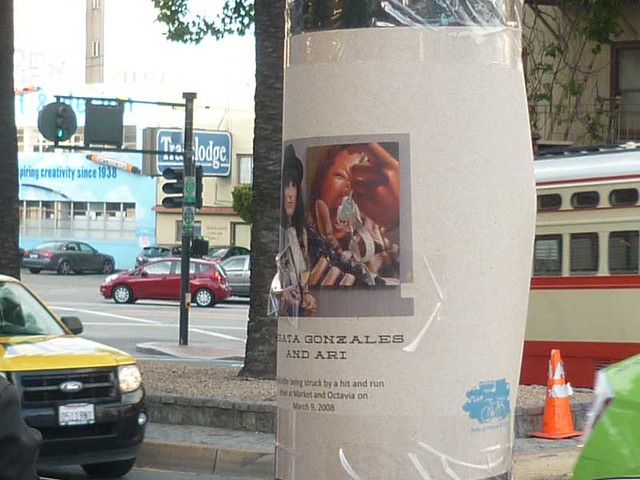
San Francisco cyclist who died after accident is focus of benefit
There’s hope that the new automated photo enforcement system that was activated in November 2013 will keep vehicles from making the illegal right turn onto 101 South that cuts through the bike lane and pedestrian crosswalk. There’s also the hope that instead of mostly reacting to tragedies the city will increasingly take the most proactive and visionary approach to bicycle infrastructure.
For example, adopting the design that includes a continuous separated bikeway from Octavia to the Embarcadero from the Better Market Street initiative would also go a long way in eliminating these types of heartbreaking gatherings in the future…

With these thoughts in mind, we pedaled down Valencia Street before making a left turn onto one more notoriously dangerous thoroughfare, 16th Street.

At the corner of South Van Ness, Devon and Anthony pulled over one last time that day to honor a young man who lost his life only two weeks after arriving in San Francisco.
Dylan Mitchell, 21, 16th and South Van Ness
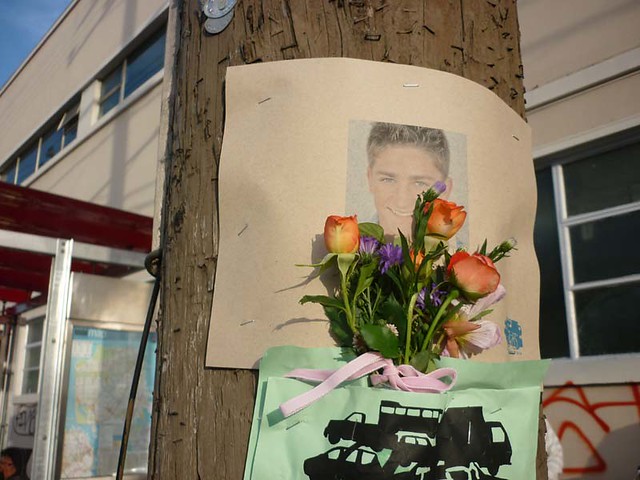
Bicyclist killed in collision with San Francisco garbage truck was 21-year-old from Clayton
This one is particularly hard to digest of for me personally, as I’m a big fan of Recology and their fleet of alternative fuel trucks that play a huge role in getting San Francisco to Zero Waste by 2020. As Dylan was pedaling straight down 16th Street trying to get to his apprenticeship as an electrician, the Recology truck driver was trying to complete his route to collect our compost and recycling bins, making a right turn onto South Van Ness. The driver obviously did not see Dylan, and it’s hard to say whether a bike lane would have prevented the tragedy at that very moment. It’s fair to say though that a bike lane may have led the driver to look twice before turning.
What we do know is that regardless of who did what and when that morning, while this must undoubtedly have been a harrowing experience for the truck driver as well, it was Dylan whose photo Devon had to staple on the pole, along with the poster and flowers.
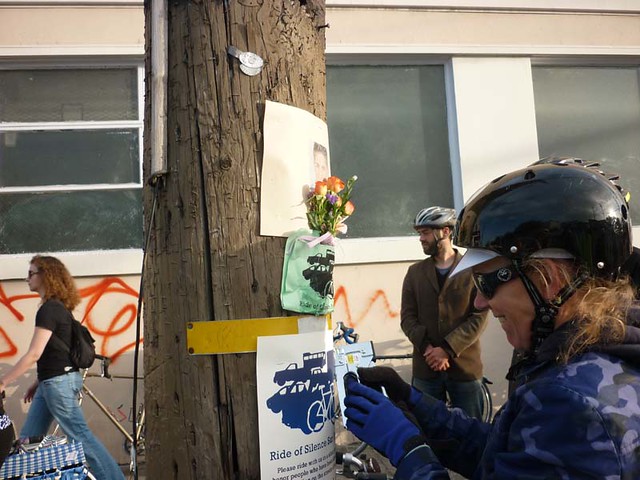
An emotionally and at times physically challenging ride ended with a bunch of us gathering for food, drink, and soul exchange right up the street.
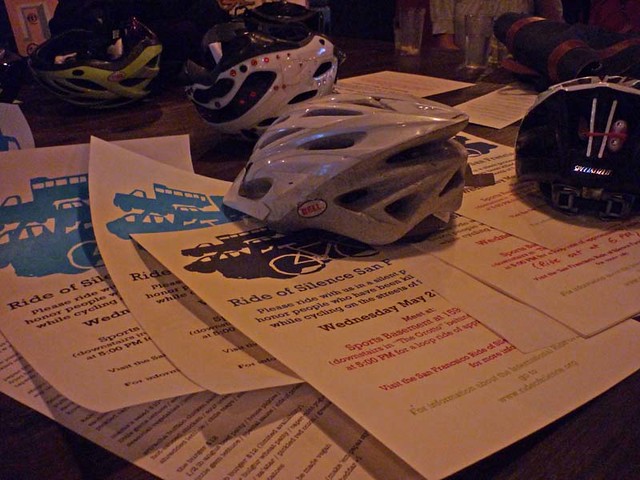
o~O~o~O~o~O~o~O~o~O~o~O~o~O~o~O~o~O~o
Check out Jeremy Raff’s video of the ride
crossposted at Daily Kos

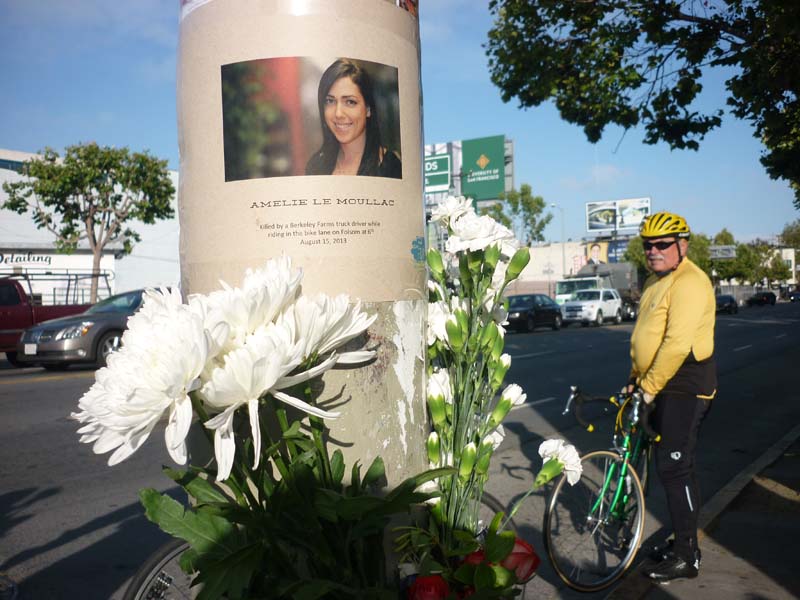
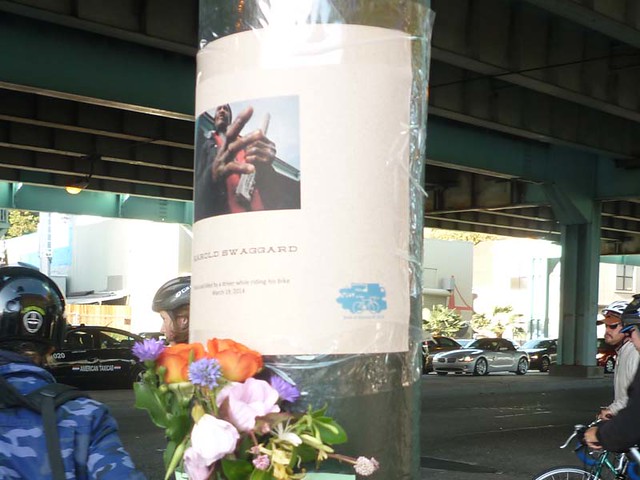
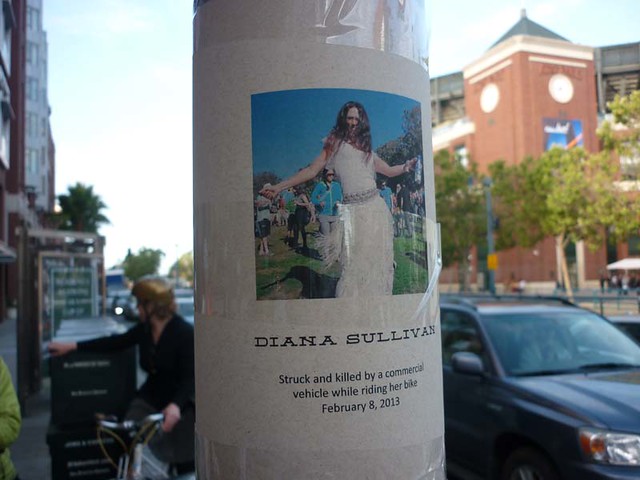


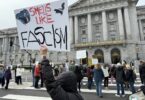


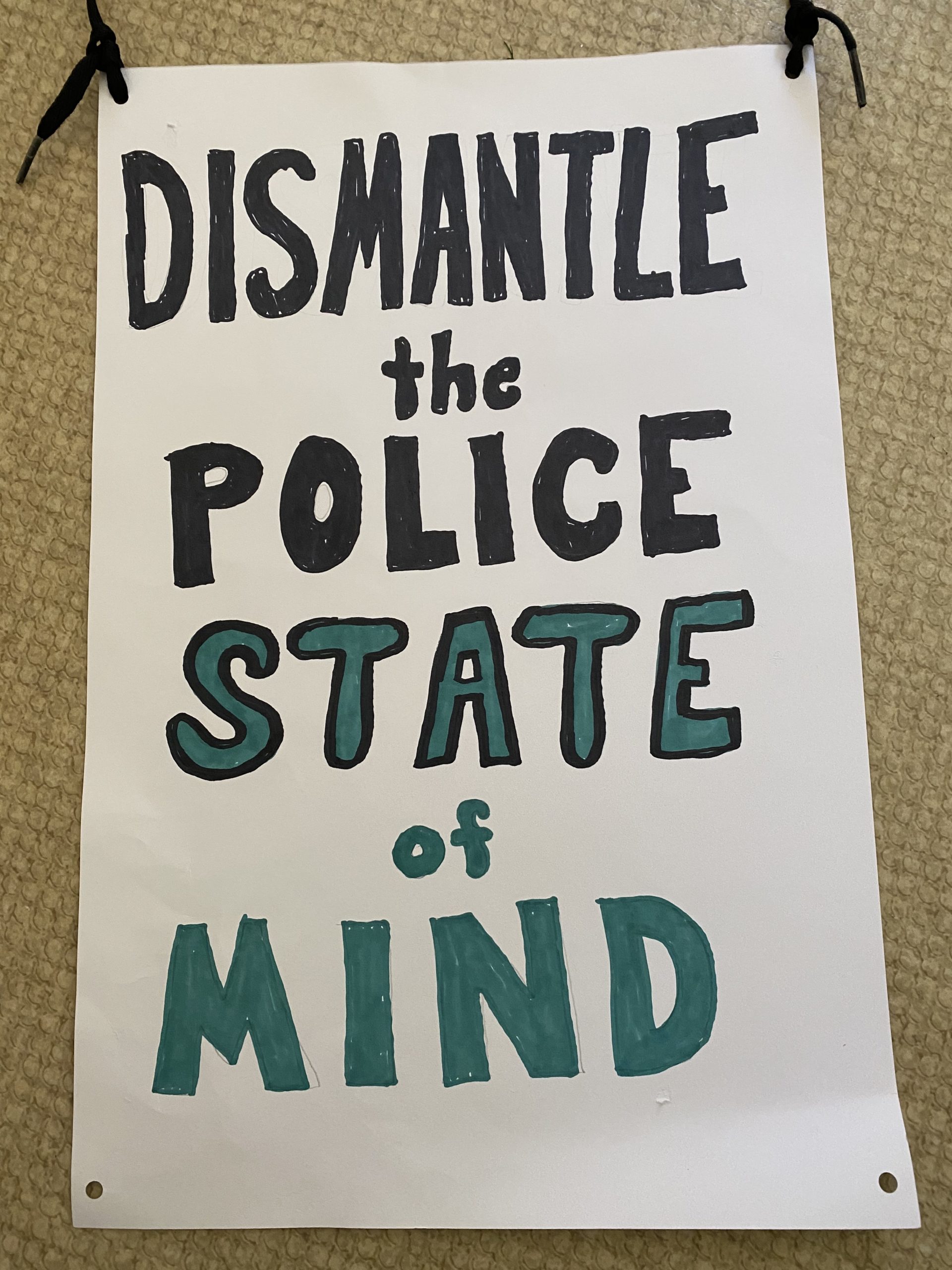

This speaks volumes: “In fact, Market Street now carries more people on bike than it does people driving,”
Hitting a pedestrian is a horrific possibility that most drivers put out of their minds. When I was 10, I was hit by a car. I hesitated before crossing the street, thinking I had time to get to the other side. The woman who hit me was inconsolable. I never blamed her and came through it with just a few bruises, aches, and better respect for patience.
Your empathic inclusion of the Recology driver’s perspective is an important part of the bike vs. car debate. And your in depth analysis raises a rooted question: However horrific the internal guilt of accidentally killing someone, is the resistance to sharing the road tied to a concern for legal liability and guilt?
I remember the reaction of the woman who hit me as sincere concern for a little girl’s well-being, but how much of it was, “OMG, I’m going to jail?” Hit a bike on the open road, liability is uncertain; hit a bike in a designated bike lane, liability is all yours.
Furthermore, if I hesitated to think of just how dangerous the whole notion of driving a car really is — for me or those around me — I would freeze in fear. (Therein is just one more reason to ride or walk.) Instead, I try my best to drive safely and put out of my mind the likelihood and consequences of messing up. Rather than face reality, shielded by the laws of conformity, praying that I never have to know how that Recology driver feels, I drive on.
That is until I get to a place like Market Street.
Thank you for the reminder that with a driver’s license comes great responsibility. May we all begin to face the realities of this dangerous culture in order to make way for a far better alternative.
yikes, sorry to hear about your encounter with a car when you were young, Ruth. In some ways I suppose we can draw some good things from those kinds of experiences, as they alert us to just how quickly something like it can happen, and to simply be more aware when moving about, no matter what vehicle or by foot. Personally, I think part of the problem of why collisions have been spiking here in SF is the level of distraction that has gone up dramatically right here in the heart of gadget making.
Good point about the legal liability vs guilt. My feeling it’s probably a mix of the two for most people, where the moment right after you’ve caused an accident you feel bad about what might have happened to the other person, mixed in with a healthy helping of self-concern about the ramifications. I do think that’s only human, but considering how quickly people seem to know what the possible consequences might be right after impact, it is quite surprising how reckless so many of us are when we get onto the road. Personally, I had no idea that there aren’t any consequences in the U.S. for killing a cyclist or pedestrian with your car, as it would be automatically the driver’s fault where I’m from in Germany.
And yes, it’s worth pointing out that driving a car itself is quite dangerous, not only to pedestrians & cyclists, but other drivers. There are 33,000 deaths from motor vehicle accidents each year, and I’m thinking that a lot of them are car vs car. There’s something in our psychology that downplays just how dangerous it is to have so many of these heavy equipment pieces operated on small roads. I think that’s part of the bargain we’ve made when we accepted cars as the primary mode of transportation, and it’s hard to undo that overnight. But it’s definitely worth being more aware about all the cause and effect, so that we can slowly make changes towards more human-scale living wherever possible.